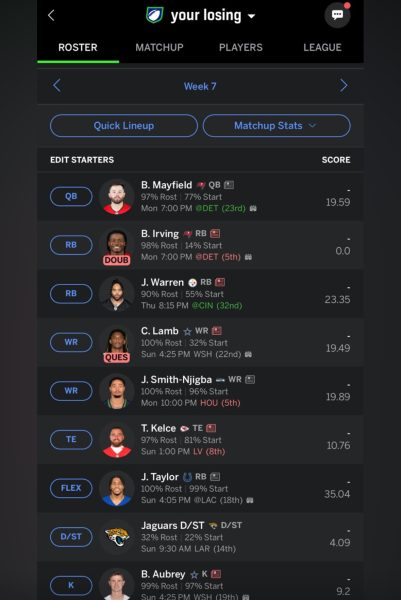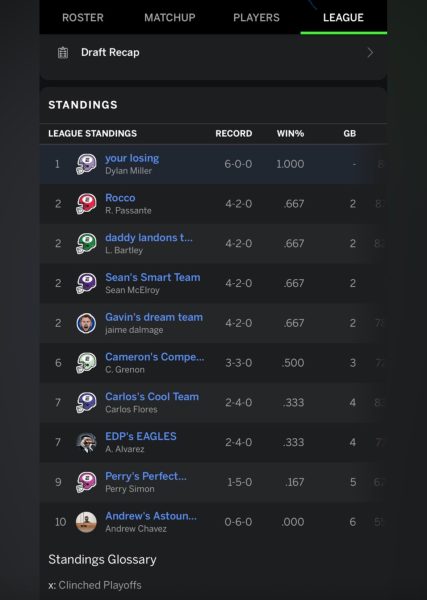The fall time comes with many things: apple picking, Halloween, and leaves changing colors. The most important thing that happens in the fall, though, is football. On September 4th,the NFL season started, but before that, 29 million Americans started their annual fantasy football drafts, including many Morgan students. Some of these students are good and have experience that some lack. They have strategies and tactics that are important and not spoken about, until now. Pawprint reached out to some of the most successful fantasy football players at Morgan to learn about their strategies.
Rolling with Run Game:
Dylan Miller, a freshman, has a record of six wins and zero losses this year, and his favored strategy for the draft was called the power back strategy. “I take the two best running backs that are available with the picks I have. The way I see it, they touch the ball a lot and will get me the points.” This strategy was even supported by Christopher Zawadski, a teacher at The Morgan school who is a huge fan of football and spends time each weekend analyzing the NFL. Zawadski say. “Running backs are the most reliable position in the sport. When the quarterback gets hurt, the running back doesn’t get as affected as a wide receiver. In fact, they get more touches of the ball.”
“When looking to draft a quarterback, it’s important to note that consistency is key,” says Zawadski. He believes it is important to take a quarterback who has solid receivers and good protection from his O-lineman, and who doesn’t turn over the ball a lot.
For example, a quarterback like Jared Goff is good, “He throws the ball well and has a great O-Line, as well as multiple options down the field,” said junior Jacoby Brown, who currently sits at a 6 and 1 record in his fantasy football league. “If you are going to get a running back, then you need to see prior injuries and how his O-Line is. When you get a receiver, you need to look at his quarterback. I wouldn’t draft a receiver high if their quarterback is Joe Flacco,” Zawadski explained.
When Joe Burrow went down earlier in the year, star receiver Ja’Marr Chase had to settle with a backup quarterback who did not give the same production. Now his quarterback is Joe Flacco who is still not a star quarterback and will struggle to get Chase the ball as much. Prior to Joe Burrow’s injury Ja’Marr had been averaging 20.06 fantasy points and now with the backup quarterback he is averaging 12.2 fantasy points. An 8 point downgrade can be the difference between winning and losing. Chase went from star receiver numbers to second option receiver numbers.

Freshman Dylan Miller’s team prior to the week 7 games
Pounce on Panic:
It’s important to take from people who panic, advises Zawadski. “People panic when a big player underperforms the first few weeks. The season is long and people will take a bag of Lays chips for a great player just because he isn’t playing well,” explained Zawadski.
In every fantasy football league, there is that one person who makes five trades a week and their team looks different every day. Trades can be difficult and scary to manage. When making a trade or accepting a trade always think of what you will get in return and what you need. “If I have two really good tight ends I might offer a trade to someone who needs a tight end. I would give them my backup tight end and take a player who I need in a specific position,” said Zawadski.
Stay away from the big names:
Big names are the death of all new fantasy football managers. They draft and trade for players that they have heard about, not knowing whether they are quality players or not. This was true for Zawadski, who finished seventh two years ago because of a bad pick-up.
“A couple of years ago, I drafted Ezekial Elliot. He was looked at as a top five player in the league. I drafted him pretty highly and in between injuries and his O-Line getting banged up, he had a terrible season,” said Zawadski. Elliott had an average of 10.3 fantasy points per game in the 2023 season. These numbers are very subpar for a running back of his caliber and hype. The year prior Elliott averaged 14.9 fantasy points and did not have nearly as much hype as the next year. To this day Eliott’s career has fallen off tremendously and he is a shadow of his previous self. So far this season a current player on the bust list is Caleb Williams who has become much harder to start in fantasy as he has only surpassed 200 passing yards in one of the past 4 games. Dangerous number for a number one option quarterback in fantasy football this year.

Bye. Bye. Bye.
The importance of knowing your player’s bye weeks is very important, warned Brown. “You want to check your lineup frequently for trades and for bye weeks. Make sure you can get as many points as possible, and don’t take a zero in any column,” said Brown. Brown explained the importance of keeping players in your starting lineup that are actually playing in order to receive maximum points.
Fantasy football is very intricate and champions are made in the details. Details when drafting, when trading, and even not panicking when the going gets tough. Losing a star receiver can cost you about 14 to 16 points a game on average. When you multiply 16 by the number of games played this season which is 17 you get 272 points in total you could be missing out on just for losing a player. For example, Ja’marr Chase will not finish this season with as many points as expected due to Burrow’s injury. Fantasy football is a game of numbers, and let’s face it, numbers are hard. The winners of Fantasy football are those who know how to manage the numbers the best.


